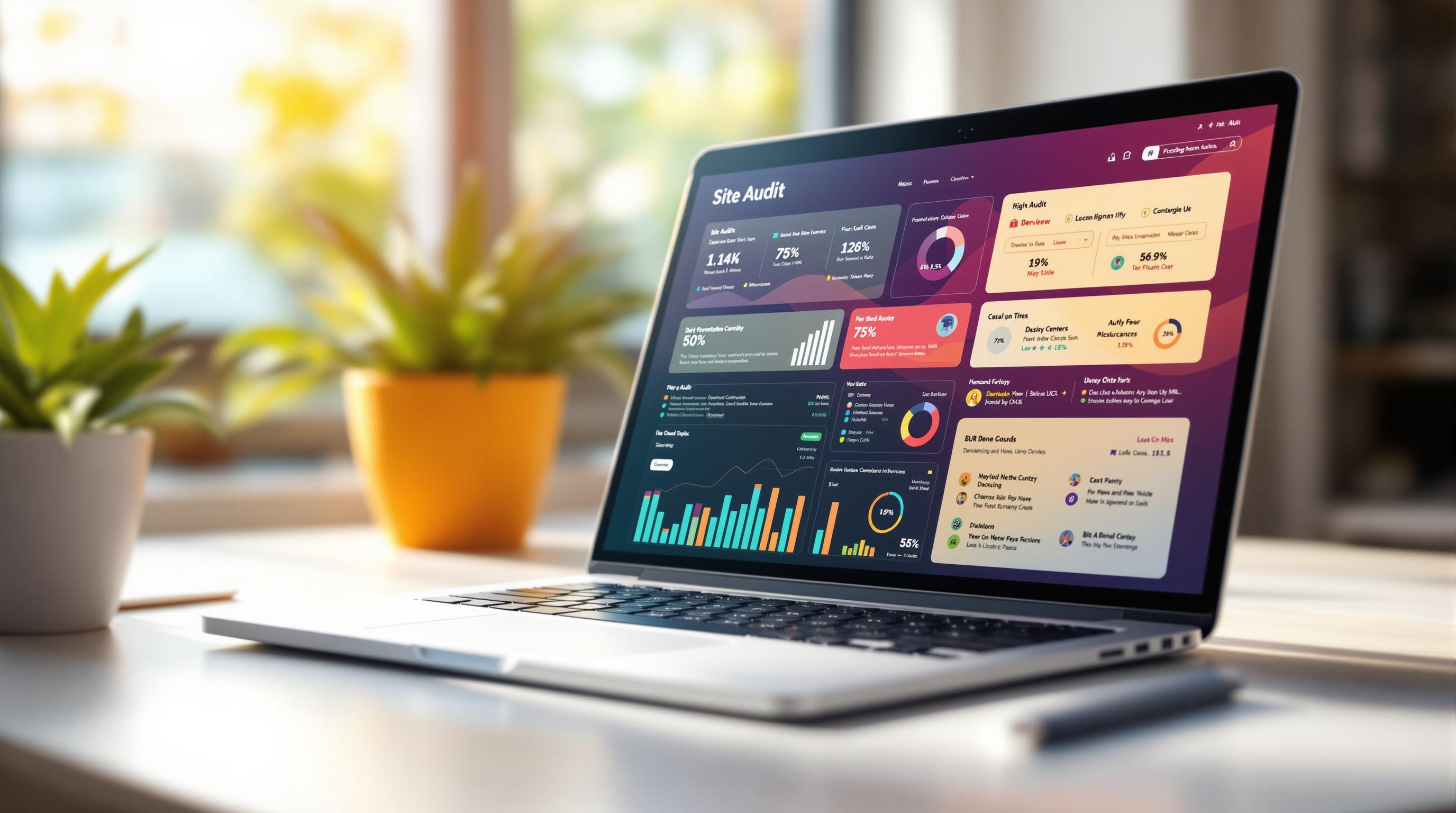Tracking SEO ROI is crucial for small businesses with tight budgets. It helps you see which strategies drive the most value. Here's a quick guide:
-
Key Metrics to Track:
Focus on conversion rates, organic traffic growth, revenue from SEO, and cost per acquisition. These show how well your SEO efforts are paying off. -
Affordable Tools:
Use free tools like Google Analytics and Google Search Console to monitor traffic, conversions, and keyword performance. -
ROI Formula:
Calculate ROI with this simple formula:
(Revenue from SEO - SEO Cost) / SEO Cost × 100%.
Example: If you spend $5,000 and earn $25,000, your ROI is 400%. -
Cost Breakdown:
Typical monthly SEO costs include:- Tools: $0–$99
- Content: $200–$1,000
- Technical SEO: $100–$500
- Outsourced Services: $300–$1,000
-
Budget-Friendly Strategies:
- Targeted Keywords: Focus on long-tail and local keywords for better conversions.
- Local SEO: Optimize your Google My Business profile and target location-specific searches.
- Content Updates: Refresh old content with new stats and better readability.
Understanding SEO ROI Basics
What Is SEO ROI and Its Importance?
SEO ROI is all about determining the financial return from your search engine optimization efforts. It helps businesses, especially those mindful of their budgets, figure out which strategies work best. This makes it easier to justify spending and plan future investments wisely.
Calculating SEO ROI
Here's the simple formula to calculate SEO ROI:
(Total Revenue – SEO Cost) / SEO Cost × 100%
For instance, if your SEO efforts bring in $200,000 in revenue, and you spent $40,000, the calculation would look like this: ($200,000 - $40,000) / $40,000 × 100% = 400% [1][2].
Metrics to Track for SEO ROI
To measure SEO ROI effectively, keep an eye on these key metrics:
| Metric | What to Track | Why It Matters |
|---|---|---|
| Organic Traffic | Visitors from search engines | Reflects your reach and visibility. |
| Conversion Rate | Actions visitors take | Highlights how effective your site is. |
| Revenue | Income from organic visitors | Directly ties to your ROI. |
| Cost per Acquisition | Cost per converted customer | Shows how efficient your strategy is. |
Focus on long-term trends rather than isolated data points when analyzing these metrics. This approach helps you determine which SEO efforts yield the best results, making it easier to allocate resources smartly. By keeping an eye on these numbers, you can pinpoint the strategies that deliver the most value and adjust your budget accordingly [3].
Now, let's dive into strategies to get the most out of your SEO efforts without overspending.
Preparing for SEO ROI Measurement on a Budget
Calculating SEO Costs
To figure out your SEO ROI, you first need to determine how much you're spending. Here's a breakdown of typical SEO-related expenses:
| Cost Category | Examples | Typical Monthly Range |
|---|---|---|
| Tools & Software | Google Analytics (Free), Ahrefs Lite | $0 - $99 |
| Content Creation | Blog posts, meta descriptions | $200 - $1000 |
| Technical SEO | Site audits, optimization | $100 - $500 |
| Outsourced Services | Consulting, link building | $300 - $1000 |
Using Affordable Tools for Tracking
You don’t need to break the bank to track your SEO performance. Free tools from Google can give you almost everything you need. Google Analytics helps you monitor traffic, user behavior, conversions, and revenue, while Google Search Console provides insights into keyword rankings, click-through rates, and technical SEO issues - all at no cost [1][2].
After collecting data from these tools, the next step is linking that information to your revenue.
Tracking Revenue from SEO
To connect SEO efforts to revenue, set up conversion goals in Google Analytics. These could include purchases, form submissions, or signups. Assign a monetary value to each goal based on historical data. For example, if 10% of form submissions lead to a $1,000 sale, you can estimate each submission is worth $100 [2][3].
Google Analytics' attribution models can help you understand SEO's role in driving revenue. Last-click models show direct conversions, while multi-channel funnels highlight SEO's indirect contributions to sales [2][3].
Once you have these insights, you can focus on refining strategies that maximize returns without overspending.
Cost-Effective SEO Strategies for Better ROI
Focusing on Targeted Keywords
Instead of wasting money on broad, competitive keywords, focus on specific terms that your audience actively searches for. This strategy attracts more qualified visitors and boosts conversion rates.
| Keyword Type | Why It Works |
|---|---|
| Long-tail Keywords | Easier to rank for, better conversions |
| Local Keywords | Reaches a specific geographic audience |
| Question-based Keywords | Increases chances of appearing in featured snippets |
By narrowing your focus, you can stretch your budget further and drive meaningful results.
Using Local SEO for Better Results
Local SEO is a goldmine for small businesses looking to maximize ROI. Start by optimizing your Google My Business profile - ensure your hours, services, and contact details are accurate, and encourage customers to leave reviews.
Here are some effective local SEO tactics:
- Target keywords like "best [service] in [city]"
- Build location-specific landing pages to cater to local audiences
- Actively gather and respond to customer reviews to boost credibility
- Keep all business information updated and consistent across platforms
These steps can help you stand out in local searches and attract nearby customers.
Improving Existing Content
Your existing content can often be a hidden asset. Use tools like Google Analytics to find pages with good traffic but low engagement, then make updates to improve their performance.
Here’s how to optimize for better results:
- Refresh outdated content: Add current stats, examples, and insights to keep it relevant.
- Improve readability: Use shorter paragraphs, clear subheadings, and internal links to make content easier to digest.
- Repurpose successful content: Turn a popular blog post into an infographic, video, or another format to reach new audiences and boost SEO with diverse media types.
These tweaks can breathe new life into your content and deliver stronger returns for your efforts.
sbb-itb-d7fe25c
How to Measure SEO ROI Like a Pro
Examples: Measuring SEO ROI on a Budget
Let’s look at how affordable SEO strategies can drive real results.
Case Study: Small Business SEO Success
Local Delights, a family-run bakery in Portland, showed how smart SEO efforts can pay off - even with limited resources. By using free tools like Google Search Console and Google Analytics, they tracked and improved their performance over six months:
| Metric | Before SEO | After SEO | Improvement |
|---|---|---|---|
| Monthly Organic Traffic | 1,200 visits | 4,800 visits | 300% increase |
| Local Search Visibility | Page 3-4 | Top 3 results | Noticeable boost |
| Monthly Online Orders | 45 orders | 180 orders | 400% increase |
| SEO Investment | $0 | $500/month | Positive ROI |
Their approach focused on localized SEO tactics, including:
- Optimizing their Google My Business profile for better visibility.
- Creating landing pages tailored to specific neighborhoods.
- Targeting local keywords to connect with nearby customers.
With a total spend of $3,000 over six months, the bakery generated $27,000 in revenue - an impressive 800% ROI.
Lessons from Budget-Friendly SEO Campaigns
The Local Delights example highlights how small businesses can use SEO to see real growth. The key? Focus on metrics that matter, like conversion rates and revenue from organic traffic. For Local Delights, prioritizing local search yielded better results than trying to compete on a national level - most of their orders came from nearby customers.
Conclusion: Actions to Measure and Improve SEO ROI
Key Points from the Article
Tracking SEO ROI on a budget means focusing on the right metrics and making smart use of free tools. By leveraging these resources, businesses can monitor key performance indicators and make informed decisions.
Here are some strategies that balance cost and impact:
| Strategy | Cost-Effectiveness |
|---|---|
| Local SEO | High impact with minimal expense |
| Content Updates | Strong returns over time |
| Targeted Keywords | Great value for low cost |
| Technical SEO | Moderate cost, lasting results |
Next Steps for Small Businesses
1. Audit Your SEO Performance
Start by analyzing your current SEO standing. Use tools like Google Search Console to check your rankings and find areas for improvement [1]. Focus on pages with the most room for growth and document your starting metrics to track progress.
2. Set Up Tracking and Review Systems
Make sure you're monitoring the right data. Configure Google Analytics to track critical actions like conversions [3]. Keep an eye on organic traffic trends, user behavior, and revenue changes. Regular monthly reviews will help you spot patterns and fine-tune your strategy.
3. Focus on High-Impact Strategies
Put your energy into tactics that deliver results. Optimize for local SEO to boost visibility quickly [1]. Refresh and improve existing content to enhance search rankings. Use targeted keywords that align with your business goals, and tackle technical SEO improvements step-by-step.
FAQs
How do you measure ROI for SEO?
To measure ROI for SEO, you need to track key metrics and analyze financial outcomes. As detailed in the "Metrics to Track for SEO ROI" section, keep an eye on organic traffic, conversions, and revenue using tools like Google Analytics and Search Console. The formula to calculate ROI is straightforward:
(Revenue from SEO - Cost of SEO) / Cost of SEO x 100 [1]
For instance, if your SEO campaign costs $20,000 and generates $120,000 in revenue, your ROI would be 500% [3].
How to demonstrate the conversion and ROI of an SEO tactic?
Proving the impact of an SEO tactic involves linking specific actions to measurable results. Tools like Google Analytics and Search Console can help with this [3]. Focus on these areas:
-
Direct Revenue Impact
Track sales from organic search traffic, monitor form submissions or contact requests, and measure engagement metrics like time spent on your site. -
Local SEO Performance
Keep an eye on customer actions such as profile views and requests for directions. Track local search rankings and visibility, as well as calls and website visits from local searches [1]. -
Overall Campaign Success
Use Google Analytics to see how SEO contributes to direct and indirect conversions. Monitor changes in organic visibility and document improvements in keyword rankings.
It's crucial to account for both immediate conversions and SEO's influence on longer customer journeys. Consistently tracking these metrics helps showcase how SEO efforts drive real business outcomes.
Want to maximize your SEO ROI? Check out earlier sections for tips on cost-effective strategies and tools designed to help you achieve more with fewer resources.


